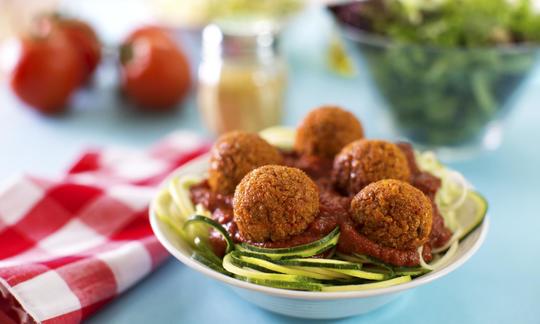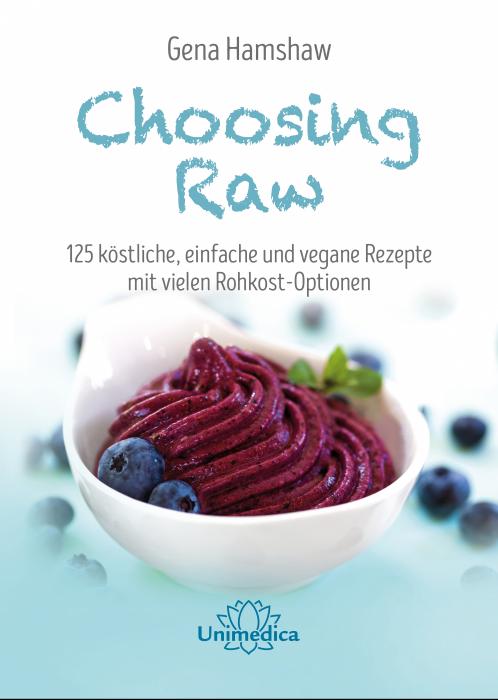Zucchini Pasta with Vegetarian Quinoa Meatballs
vegan
Ingredients (for servings, )
| For the zucchini pasta | |
|---|---|
| 4 | Baby zucchini, raw (organic?) (1.5 oz) |
| For the vegetarian quinoa “meatballs” | |
| 2 ½ oz | Tomatoes, dried (raw?, organic?) |
| 1 tbsp | Olive oil (cold pressed, raw?, organic?) (0.47 oz) |
| 1 | Onions, raw (organic?) (3.9 oz) |
| 1 clove | Garlic (organic?) (0.11 oz) |
| 3 ¼ oz | Cultivated mushrooms, raw (organic?) |
| 15 oz | Quinoa, cooked (organic?) |
| 1 tsp, ground | Oregano, dried (raw?, organic?) (0.06 oz) |
| 3 ¼ oz | Beans, white, cooked, without salt (Alubia) |
| 1 dash | Sea salt (raw?, organic?) (0.01 oz) |
| 1 dash | Black pepper (organic?, raw?) (0.00 oz) |
| For the raw marinara sauce | |
| 1 ⅞ oz | Tomatoes, dried (raw?, organic?) |
| 1 tbsp | Drinking water, raw (organic?) (0.20 oz) |
| 11 oz | Tomatoes, raw (organic?) |
| ¼ tsp | Sea salt (raw?, organic?) (0.04 oz) |
| 1 tbsp | Apple cider vinegar (raw?, organic?) (0.52 oz) |
| 1 tbsp | Maple syrup (organic?, raw?) (0.70 oz) |
| 1 tsp, ground | Oregano, dried (raw?, organic?) (0.06 oz) |
| ¼ bunch | Basil, fresh (organic?) (0.35 oz) |
Equipment
- blender or hand-held blender / immersion blender or food processor
- spiralizer or vegetable peeler
- skillet (frying pan)
- stove
- oven
- baking sheet (cookie sheet)
Type of preparation
- cook
- bake
- chop or grind
- soak
- sauté
- sweat
- meld
- season to taste
- purée
- rinse with cold water
- drain
Preparation
For the zucchini pasta
Cut four small zucchini into spaghetti using a spiralizer or vegetable peeler.For the vegetarian quinoa “meatballs”
Soak the sun-dried tomatoes in warm water for at least 10 minutes and then let drain.Heat the olive oil in a large sauté pan on medium heat. Cube the onions and chop the garlic. Sauté both in the olive oil for about 5 minutes, or until they are translucent.
Chop the mushrooms, add to the pan, and cook until they are soft (about 4–5 minues).
Add the sun-dried tomatoes, quinoa, oregano, and beans. Stir for about 2 minutes until everything is warm and evenly mixed. Season to taste with salt and pepper.
Purée everything in a mixer (or food processor).
Form the mixture into balls that are about 2.5 cm in diameter and then let rest for 30 minutes so that the flavors can meld. In the meantime, preheat the oven to 205°C and line a large baking sheet with parchment paper. Place the balls on the paper so that they are evenly spaced and bake 20–25 minutes, until they are golden brown.
A recipe for four servings yields about 24–30 vegetarian quinoa meatballs. These can be stored in the refrigerator for four days and can also be frozen.
For the raw marinara sauce
Chop the sun-dried tomatoes and soak for about 10 minutes. Then let drain.Finely purée all of the ingredients with 1 tablespoon water in a blender or food processor.
A recipe for four servings yields about 500 ml of sauce. This can be stored in the refrigerator for five days or frozen, if necessary.
Serving
Divide the zucchini into the individual bowls. Top with marinara sauce and meatballs.
|
Nutritional Information per person
Convert per 100g
|
2000 kcal | |
|---|---|---|
| Energy | 313 kcal | 15.6% |
| Fat/Lipids | 6.8 g | 9.7% |
| Saturated Fats | 0.94 g | 4.7% |
| Carbohydrates (inc.dietary fiber) | 55 g | 20.5% |
| Sugars | 19 g | 21.5% |
| Fiber | 11 g | 42.1% |
| Protein/Albumin | 13 g | 26.1% |
| Cooking Salt (Na:200.9 mg) | 510 mg | 21.3% |
| Essential micronutrients with the highest proportions | per person | 2000 kcal | |
|---|---|---|---|
| Min | Manganese, Mn | 1.8 mg | 88.0% |
| Elem | Potassium, K | 1'715 mg | 86.0% |
| Min | Copper, Cu | 0.86 mg | 86.0% |
| Vit | Vitamin B9, B11 (Folate, as the active form of folic acid) | 115 µg | 57.0% |
| Elem | Phosphorus, P | 368 mg | 53.0% |
| Prot | Tryptophan (Trp, W) | 0.13 g | 53.0% |
| Vit | Vitamin K | 38 µg | 50.0% |
| Elem | Magnesium, Mg | 161 mg | 43.0% |
| Min | Iron, Fe | 5.8 mg | 42.0% |
| Prot | Threonine (Thr, T, irreversibly transaminated) | 0.39 g | 42.0% |
Detailed Nutritional Information per Person for this Recipe
The majority of the nutritional information comes from the USDA (US Department of Agriculture). This means that the information for natural products is often incomplete or only given within broader categories, whereas in most cases products made from these have more complete information displayed.
If we take flaxseed, for example, the important essential amino acid ALA (omega-3) is only included in an overarching category whereas for flaxseed oil ALA is listed specifically. In time, we will be able to change this, but it will require a lot of work. An “i” appears behind ingredients that have been adjusted and an explanation appears when you hover over this symbol.
For Erb Muesli, the original calculations resulted in 48 % of the daily requirement of ALA — but with the correction, we see that the muesli actually covers >100 % of the necessary recommendation for the omega-3 fatty acid ALA. Our goal is to eventually be able to compare the nutritional value of our recipes with those that are used in conventional western lifestyles.
| Essential fatty acids | per person | 2000 kcal |
|---|---|---|
| Linoleic acid; LA; 18:2 omega-6 | 1.8 g | 18.0% |
| Alpha-Linolenic acid; ALA; 18:3 omega-3 | 0.17 g | 8.0% |
| Essential amino acids | per person | 2000 kcal |
|---|---|---|
| Tryptophan (Trp, W) | 0.13 g | 53.0% |
| Threonine (Thr, T, irreversibly transaminated) | 0.39 g | 42.0% |
| Isoleucine (Ile, I) | 0.41 g | 33.0% |
| Lysine (Lys, K, irreversibly transaminated) | 0.62 g | 33.0% |
| Phenylalanine (Phe, F) | 0.48 g | 31.0% |
| Valin (Val, V) | 0.50 g | 31.0% |
| Leucine (Leu, L) | 0.67 g | 28.0% |
| Methionine (Met, M) | 0.19 g | 20.0% |
| Vitamins | per person | 2000 kcal |
|---|---|---|
| Vitamin B9, B11 (Folate, as the active form of folic acid) | 115 µg | 57.0% |
| Vitamin K | 38 µg | 50.0% |
| Vitamin C (ascorbic acid) | 30 mg | 37.0% |
| Vitamin B1 (Thiamine) | 0.38 mg | 35.0% |
| Vitamin B2 (Riboflavin) | 0.47 mg | 34.0% |
| Vitamin B3 (Niacin) | 4.9 mg | 30.0% |
| Vitamin B6 (pyridoxine) | 0.41 mg | 30.0% |
| Vitamin B7 (Biotin, ex vitamin H) | 12 µg | 25.0% |
| Vitamin B5 (Pantothenic acid) | 1.2 mg | 20.0% |
| Vitamin E, as a-TEs | 1.7 mg | 15.0% |
| Vitamin A, as RAE | 55 µg | 7.0% |
| Vitamin D | 0.04 µg | 1.0% |
| Vitamin B12 (Cobalamin) | 0.01 µg | < 0.1% |
| Essential macroelements (macronutrients) | per person | 2000 kcal |
|---|---|---|
| Potassium, K | 1'715 mg | 86.0% |
| Phosphorus, P | 368 mg | 53.0% |
| Magnesium, Mg | 161 mg | 43.0% |
| Sodium, Na | 201 mg | 25.0% |
| Calcium, Ca | 110 mg | 14.0% |
| Essential trace elements (micronutrients) | per person | 2000 kcal |
|---|---|---|
| Manganese, Mn | 1.8 mg | 88.0% |
| Copper, Cu | 0.86 mg | 86.0% |
| Iron, Fe | 5.8 mg | 42.0% |
| Zinc, Zn | 2.5 mg | 25.0% |
| Selenium, Se | 8.0 µg | 15.0% |
| Iod, I (Jod, J) | 7.1 µg | 5.0% |
| Fluorine, F | 5.4 µg | < 0.1% |
Narayana Verlag GmbH /Unimedica Verlag , Gena Hamshaw
Raw recipes 80 (2), Cooked recipes 45 (1)
Additional photos (7)
Gena Hamshaw's "Choosing Raw - 125 Delicious, Easy, and Vegan Recipes with Many Raw Food Options" contains many easy-to-make vegan and raw ideas.
Since this book is written in German, a description is omitted here. If you are interested, please switch to German in the menu.
This zucchini pasta with cooked quinoa “meatballs” and raw zucchini noodles and marinara sauce is just like a traditional Italian home-style dish.
Raw marinara sauce: The author recommends using vine-ripened or Roma tomatoes for the tomato sauce as these tend to be the most flavorful. If the tomato skin bothers you, if you first place the tomatoes in boiling water and then transfer them to cold water, it will be easy to peel the skin off. The sun-dried tomatoes make the marinara sauce taste like it had been simmering in the pot for some time.
Beans and gas: Eating beans can cause gas to form in the large intestine, which in turn causes people to experience gas and bloating. Our intestinal bacteria are responsible for this gas as they metabolize substances that our body can’t break down. In the case of beans, our body can’t break down oligosaccharides such as raffinose. During digestion, the intestinal bacteria excrete these fermentation gases, which can cause us to experience gas.
You can reduce the formation of gas by soaking the beans 2–3 hours before cooking them. This allows a portion of the oligosaccharides to be released from the beans; however, some water-soluble vitamins and minerals are also lost in the process. Another option is to take the enzyme alpha-galactosidase before a meal. It can break down raffinose and help prevent gas and bloating. Or you can try eating spices such as coriander, anise, or caraway as a way to help relax the intestinal muscles. This makes the gas less unpleasant, but does not decrease the amount of gas the bacteria produce.
Leftover quinoa balls: The author suggests that you add any leftover quinoa balls to a salad or simply eat them as a snack.
Big batch of marinara sauce: Gena Hamshaw writes “I make a big batch of marinara sauce and then freeze it in small servings so that I can easily use the sauce for other recipes.”
Fresh herbs: Whenever possible, it is nice to use fresh herbs instead of dried ones. For four servings, you can replace 1 teaspoon dried oregano with 2 tablespoons fresh oregano.
Substitute for raw marinara sauce: Instead of raw marinara sauce, you can also use an organic store-bought tomato sauce.
Mushrooms: You can decide whether you prefer to use white or brown mushrooms or even a combination of the two.




